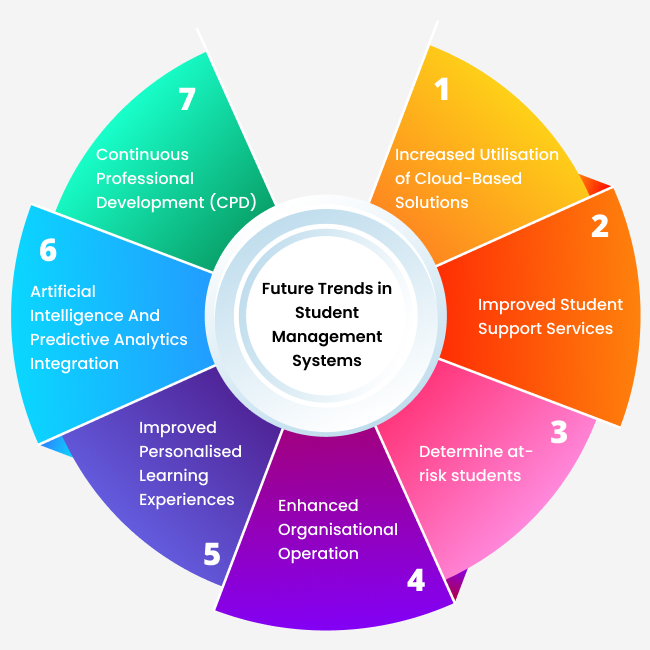29, July 2024
Facilitating quality education relies on a number of important factors, including strategic technological adoption to accelerate operations. Also, determining the institutional needs and carefully selecting the tools and solutions are equally important.
At the same time, keeping track of the future trends of prominent ed-tech tools like student management systems is a significant action plan. The main underlying reason is that it allows institutes to monitor and observe recent developments and leverage them to their benefit.
What are student management systems?
A student management system is an advanced ed-tech solution that has been designed to simplify the administrative activities of an institute. Furthermore, it provides a robust platform that helps streamline communication and data coordination between stakeholders.
Therefore, administrative staff, faculty, parents, and students are always in the loop when it comes to important announcements and impromptu changes of plans. Furthermore, it allows administrators and faculty to organise and manage crucial student data.
Tracking student information becomes easier with the system, enabling team members to view, verify, and share data without any hassle. In effect, it helps to avoid the extra time and effort that usually goes into the manual process.
On the other hand, parents remain up-to-date regarding their child’s academic and overall progress. However, keeping with technological evolutions, the student management system will also undergo an upgrade. Hence, it’s only fitting to take a look at their future trends and predictions.
Future Trends in Student Management Systems

1. Increased Utilisation of Cloud-Based Solutions
Cloud-based solutions are already popular among organisations across different sectors, and they will continue to enjoy equal or more eminence. The associated advantages, such as higher scalability and cost-effectiveness, make it a must-have feature for most tools.
Moreover, assured accessibility ensures that stakeholders can obtain data from anywhere and anytime. Likewise, the disaster recovery mechanisms enable institutes to back up and restore data, preventing them from facing data loss.
Also, institutes have the option to invest and pay for resources and integrations on a pay-as-you-go basis. Hence, they don’t need to make large, one-time investments in hardware or software.
In addition, the scalability will improve exponentially, and the system will accommodate the needs of the institute more effectively.
2. Improved Student Support Services
Unresolved admission queries, a lack of timely responses to student doubts, etc. may create a sense of student or parent dissatisfaction. That is where technological assistive tools come in handy, providing resources to improve core functions.
For example, one of the contributing factors to institutional success and outcomes is the student support service that institutes facilitate. One can see that tech-enabled admission has already been in progress for the last few years.
Nevertheless, it will only expand into further possibilities; AI-powered chatbots will become even more sophisticated, providing accurate information. Also, the integration of SIS will help to organise and auto-maintain vast amounts of student information.
Email marketing tools will be instrumental in reaching out to potential students, research partners, industry experts, etc.
10 Great Benefits Of Implementing Student Information System
3. Determine at-risk students
The development of only a specific number of students in a classroom, whereas ignoring and sidelining the rest of them, is not ideal. Accessibility to quality education is for all students, irrespective of their capabilities.
Therefore, determining the reason behind particular students’ unresponsiveness to the lesson, classes, and in-class methodologies is critical. Besides, they must equally focus on the gradual drop-outs and inability to retain students.
An appropriate solution that will be relevant in the future as it is now is the integration of the system with a student information system. Consequently, it will lead to a smooth synchronisation of student data, attendance records, and grades for teachers.
As a result, teachers will be able to get a bird's-eye view of students’ overall progress in academics since the beginning of the term. Hence, they can identify at-risk students and take appropriate measures to retain them.
4. Enhanced Organisational Operation
Carrying out multiple operations simultaneously and ensuring efficiency in all related tasks is essential for long-term efficiency. Unfortunately, that is hardly the case when institutes rely on outdated and manually intensive methods.
That is why adopting tech tools like the student information system is a strategic move because it automates complex administrative tasks. The admin does not need to spend their time collecting and maintaining a massive student database.
The system provides a centralised database, simplifying the data storage and maintenance processes. Furthermore, AI (artificial intelligence) and machine learning (ML) will improve the mechanics of the system.
As a result, it will generate accurate data on student and overall institutional performance, which can contribute to the decision-making process. For instance, teachers can use the data to identify the effectiveness of particular methods and make appropriate changes.
5. Improved Personalised Learning Experiences
The concept of student-centered learning has become one of the most significant aspects of current educational approaches. It will continue to play a decisive role in the future of educational techniques.
Hence, reliance on learning and ed-tech tools to identify student learning will continue and shape in-class lesson delivery. For instance, teachers can use SIS to personalise instructional activities according to the needs of their clients.
Besides, the system allows the teacher to keep track of individual student progress and accordingly design the learning pathways. In effect, it motivates students to attain academic goals and build upon their strengths.
Simplify Institute Tasks: MasterSoft's Student Management System
6. Artificial intelligence and predictive analytics integration
The combination of artificial intelligence (AI) and predictive analytics will have a significant impact on educational approaches. Ed-tech companies will increasingly incorporate cutting-edge technologies in the system.
As a result, it will allow educators and institute management to map data, recognise patterns, and determine future outcomes. Institutes will be able to avoid errors, inconsistencies, and miscalculations.
On the other hand, teachers can develop appropriate plans of action after identifying individual students’ weaknesses.
7. Assured Data Security and Compliance
One of the crucial priorities of the institutes is protecting sensitive student data, which is prone to hacking without proper measures. Therefore, the manufacturers of student management systems will continue to incorporate vital security features.
For example, encryption technology, access restrictions, and adherence to regulations such as the General Data Protection Regulation (GDPR) will receive top priority.
Also, these security measures ensure the protection of student information from unauthorised access or misuse. Hence, it will help to establish and maintain trust among stakeholders and the integrity of the institute.
Additionally, when the software adheres to security protocols, the vendors or service providers indicate their commitment to maintaining confidentiality and privacy. Therefore, it enables educational institutes to handle complex data protection confidently.
Wrapping it up
A student management system is an advanced ed-tech solution that is continuously evolving according to educational requirements. The future trends and predictions suggest that the system will undergo major integrations to accelerate institutional efficiency.
Furthermore, some of the future trends include cloud-based solutions to increase scalability and flexibility, improved security measures, etc.
Still wondering how NEP 2024 will revolutionise the Indian education system?
Mobile: 08448010216
Email: janki.somani@iitms.co.in












